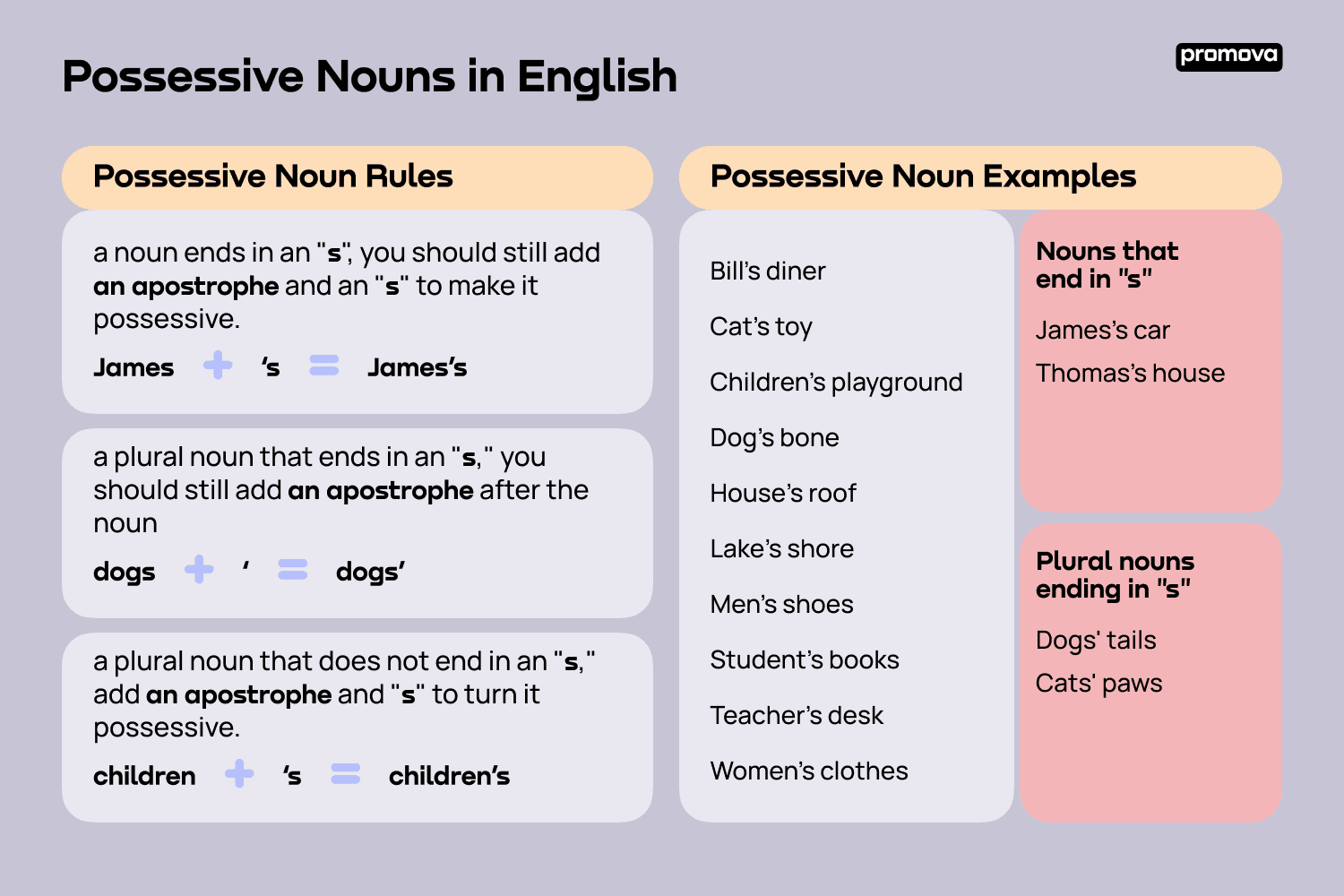Possessive Nouns in English
Contents
Possessive nouns help us understand who or what owns something. We can also use it for qualities, objects, and all sorts of useful things in grammar. In this reference, we'll explore what possessive nouns are, how to make a noun possessive, and learn to use them in sentences.
What is a Possessive Noun?
Possessive noun is a type of noun we use to show ownership. Unlike regular nouns, which refer to people, places, or things, possessive nouns indicate ownership or the relationship between two objects.
For example, "John's book" is a possessive noun because it shows that John owns the book. Similarly, "the dog's bone" is a possessive noun because it shows the relationship between the dog and the bone.
It's important to note that possessive nouns can be used to show ownership of different types of objects. For example, you can use a possessive noun to show ownership of a person, an animal, a place, an idea, or a thing.
How to Make a Noun Possessive
Making a noun possessive is a straightforward process. Just add an apostrophe and the letter "s" to the end of the noun. For example, if the noun is "car," you would add an apostrophe and "s" to make it “car's.”
You do the same when you want to show a relationship between two objects. Add an apostrophe after the noun that is being owned and then add an "s" after the object that is being owned. For example, "the dog's bone" shows the relationship between the dog and the bone.

Possessive Noun Rules
There are a few rules to understand when using possessive nouns.
First, if a noun ends in an "s," you should still add an apostrophe and an "s" to make it possessive. For example, if the noun is "James," you would add an apostrophe and the letter "s" to make it “James's.”
If you are using a plural noun that ends in an "s," you should still add an apostrophe after the noun. For example, if the noun is "dogs," you would add an apostrophe to make it “dogs'.”
Lastly, if you are using a plural noun that does not end in an "s," just add an apostrophe and "s" to turn it possessive. For example, if the noun is "children," adding an apostrophe and "s" will make it “children's.”
3
Possessive Noun Examples
Now that we've covered the rules for using possessive nouns, let's look at some examples:
- Bill's diner
- Cat's toy
- Children's playground
- Dog's bone
- House's roof
- Lake's shore
- Men's shoes
- Student's books
- Teacher's desk
- Women's clothes
Nouns that end in "s":
- James's car
- Thomas's house
Plural nouns ending in "s":
- Dogs' tails
- Cats' paws
Using Possessive Nouns in Sentences
When using possessive nouns in sentences, it's important to remember that the possessive noun should always come before the object that it is owning. For example, if you were talking about "John's book," the possessive noun "John's" would come before the object “book.”
It's also important to remember to use the correct form of the possessive noun. For example, if the noun is "John," you would use "John's," not “Johns.”
The possessive noun should be as close as possible to the object that it is owning. For example, if you were talking about "my friend's car," the possessive noun "my friend's" should be as close as possible to the object “car.”
Common Mistakes
Remember to use the correct form for your possessive noun. For example, if the noun is "John," you would use "John's," not “Johns.”
Place your noun as close as possible to the object that it is owning. For example, if you were talking about "my friend's car," the possessive noun "my friend's" should be as close as possible to the object “car.”
Finally, possessive nouns should never be used with pronouns. For example, you should never say "his's" or "hers's," as this is incorrect. You can only make nouns possessive in this way because possessive pronouns already exist.
Summary
Possessive nouns are a type of noun that shows ownership. To make a noun possessive, you simply add an apostrophe and letter "s" to the end of your noun. There are some things to remember when using possessive nouns, such as if a noun ends in an "s," you make it possessive in the same way, unless it's a plural form that ends in "s," in which case you just add an apostrophe.
With these tips and examples in mind, you should have a better understanding of English and will learn to use possessives fluently in no time!
Comments